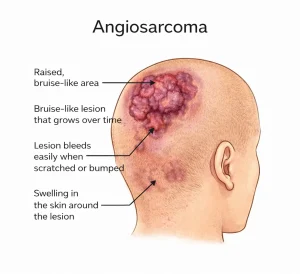Overview
Diagnosis of Angiosarcoma
Diagnosing angiosarcoma typically involves a combination of physical examinations, imaging studies, and tissue analysis. Early and accurate diagnosis plays a crucial role in determining the most effective treatment plan.
Physical exam
A healthcare professional will conduct a detailed examination to check for any visible or palpable abnormalities. This helps identify the location, size, and potential spread of the tumor.
Tissue biopsy
A sample of the suspicious tissue is removed and tested in a laboratory to confirm the presence of cancer cells. Special tests on the tissue can also help determine the type and aggressiveness of the angiosarcoma.
Imaging tests
Imaging helps assess the tumor’s size and whether it has spread to other parts of the body. Common imaging tests include:
-
MRI (Magnetic Resonance Imaging)
-
CT (Computed Tomography) scan
-
PET (Positron Emission Tomography) scan
The choice of tests depends on the tumor’s location and your overall health condition.
Treatment of Angiosarcoma
The best treatment plan for angiosarcoma depends on several factors, including the tumor’s size, location, and whether the cancer has spread. In most cases, a combination of treatments is used for better outcomes.
Surgery
Surgery aims to remove all visible cancer cells along with a margin of healthy tissue to lower the risk of recurrence. In some cases, surgery may not be possible if the cancer is too advanced or has spread to other areas of the body.
Radiation therapy
High-energy beams such as X-rays or protons are used to destroy cancer cells. Radiation may be given after surgery to kill any remaining cells or as a primary treatment when surgery isn’t an option.
Chemotherapy
Chemotherapy involves the use of powerful drugs to kill cancer cells. It may be used if the angiosarcoma has spread or in combination with radiation therapy for advanced cases.
Targeted drug therapy
Targeted therapy focuses on blocking specific molecules that help cancer cells grow. This can help slow the progression of advanced angiosarcoma and improve treatment response.
Immunotherapy
This treatment boosts the body’s immune system to recognize and attack cancer cells. Immunotherapy may be considered for advanced angiosarcoma, especially when other treatments are less effective.
Advertisement

